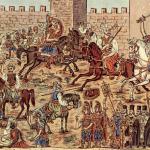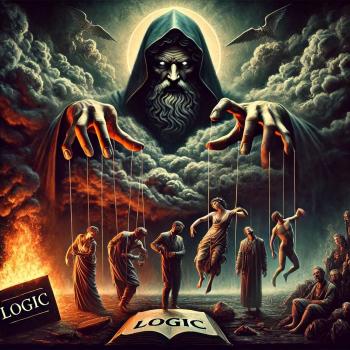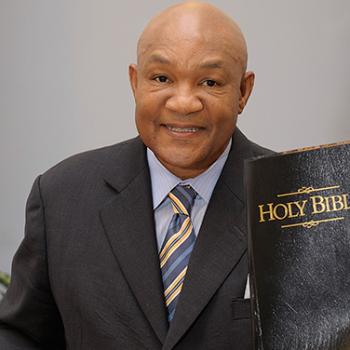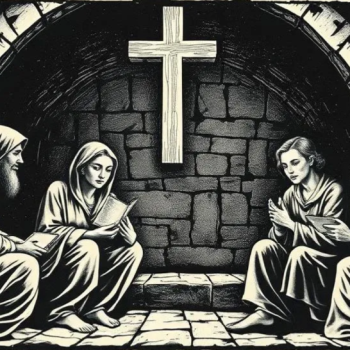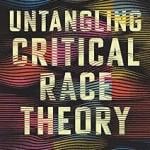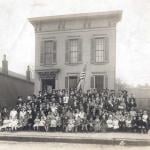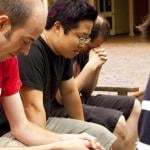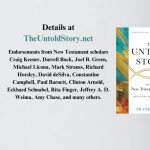As I was taking my regular Sunday-morning jog through my town’s park, I saw three flags fluttering high in the wind. There was an American flag, a Christian flag, and a third that I had never before seen: a white flag with a simple pine tree on it.
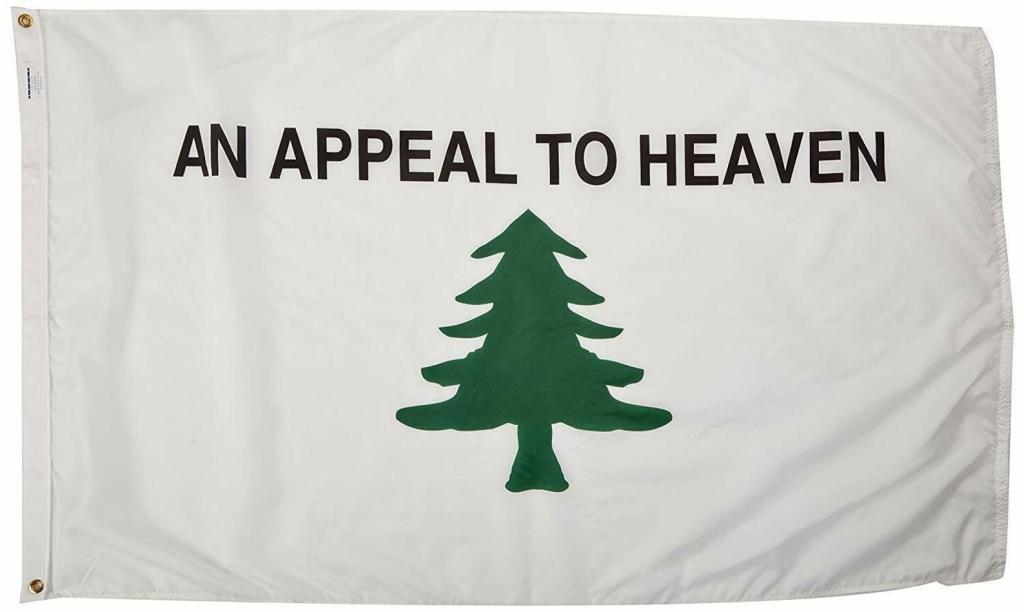 It turns out that I had encountered an attempted revival of the Ichthus Music Festival. Founded in 1970 as a Christian response to Woodstock, Ichthus went strong through the 1970s, 1980s, 1990s, and 2000s. It never got quite as big as the Creation Festival in Pennsylvania, but at its height, the three-day festival hosted tens of thousands of attendees and upwards of 100 bands—including Petra, Charlie Peacock, Switchfoot, Newsboys, Steven Curtis Chapman, and Jars of Clay.
It turns out that I had encountered an attempted revival of the Ichthus Music Festival. Founded in 1970 as a Christian response to Woodstock, Ichthus went strong through the 1970s, 1980s, 1990s, and 2000s. It never got quite as big as the Creation Festival in Pennsylvania, but at its height, the three-day festival hosted tens of thousands of attendees and upwards of 100 bands—including Petra, Charlie Peacock, Switchfoot, Newsboys, Steven Curtis Chapman, and Jars of Clay.
By the 2010s, however, flagging interest and financial difficulties doomed Ichthus.
Until, perhaps, now. Someone is trying to revive it, and as the flags flew, some bands I didn’t know practiced on stage, and a few dozen people milled about on the grass.
When I got home, I did a quick Google search for “tree on flag,” and there it was. The “Tree Flag,” or “Appeal to Heaven Flag,” really was a thing—and offered a big fat clue as to the nature of this evangelical iteration of Ichthus.
The Tree Flag originated in the Revolutionary era after the British governor of the New Hampshire colony restricted the harvest of “all white pine trees” with more than a twelve-inch diameter. The trees, he said, were to be preserved for making masts for the royal navy. He granted the “Surveyor of the King’s Woods” authority to monitor all sawmills and mark all large trees with “a broad arrow mark.” The fine for violating this order was five pounds, and any lumber made from these large pine trees was to be given to the King of England.
Many colonists did not like this law. After one mill owner was fined in 1772, a group of other millers assaulted the sheriff sent to arrest him. They gave him one lash with a tree switch for every tree the mill owners had been fined for. Moreover, these protesters cut the ears, manes, and tails off the sheriff’s horses and led them out of town as residents jeered. Almost two years before the Boston Tea Party, this so-called “Pine Tree Riot” was a striking act of colonial resistance.
Some say that the earliest iteration of the Tree Flag flew at the Battle of Bunker Hill in 1775. Indeed, you can barely make out a faint green pine tree in the upper left corner of John Trumbull’s The Death of General Warren at the Battle of Bunker’s Hill, June 17, 1775. More definite accounts suggest that the Tree Flag appeared on a squadron of six small naval vessels under the command of General George Washington in October 1775. It was a delicious irony for the rebels to fly a pine tree atop the very kind of vehicle the British wanted to harvest pine trees for.
The flag’s use expanded the following year. On July 26, 1776, just weeks after the Declaration of Independence, the Massachusetts General Court established it as the flag of the state navy. The court passed a resolution stating “. . . that the Colours be a white Flag, with a green Pine Tree, and an Inscription, ‘Appeal to Heaven.’”
This phrase comes from Chapter 14 of John Locke’s Second Treatise on Civil Government (1690), a document that refuted the theory of the divine right of kings. Locke wrote, “And where the body of the people, or any single man, is deprived of their right, or is under the exercise of a power without right, and have no appeal on earth, then they have a liberty to appeal to heaven, whenever they judge the cause of sufficient moment. And therefore, though the people cannot be judge, so as to have, by the constitution of that society, any superior power, to determine and give effective sentence in the case; yet they have, by a law antecedent and paramount to all positive laws of men, reserved that ultimate determination to themselves which belongs to all mankind, where there lies no appeal on earth, viz. to judge, whether they have just cause to make their appeal to heaven.”
Subsequently invoked by Patrick Henry in Virginia and the Second Continental Congress in Philadelphia, this phrase, which somehow got attached to the Pine Tree Riot in New Hampshire, helped bind the disparate colonies together.
Once I knew what the flag was, I saw it everywhere. The very next day I spotted a Tree Flag while driving past the front lawn of a nearby bed and breakfast. A few days after that I saw it on the stage of a Doug Mastriano campaign rally that I was watching online. A few weeks later I saw it carried by rioters while watching a documentary about the January 6 attack on the Capitol. Just last week I saw it flying in two backyards in my neighborhood.
Had I run in different circles, I would have seen it a full decade ago. The Tree Flag was used by supporters of Sarah Palin in the 2013 Million Vet March. That same year it was adopted as an emblem of a Dutch Sheets initiative that brought together “fellow believers serving Christ in public office.” Soon after, Sheets published a book entitled An Appeal to Heaven: What Would Happen If We Did It Again, which took readers on “a journey of discovering the role you were designed to play in America’s history.” The same language began appearing on daily prayer sessions posted for his 200,000 followers on YouTube. The flag also became associated with the National Day of Prayer movement.
Indeed, the Tree Flag is an almost perfect representation of Christian nationalism, especially in its use of history to valorize violence. Says Andrew Whitehead, author of Taking America Back for God: Christian Nationalism in the United States, “Christian nationalism really tends to draw on kind of an Old Testament narrative, a kind of blood purity and violence where the Christian nation needs to be defended against the outsiders. It really is identity-based and tribal, where there’s an us-versus-them.” Locke’s Second Treatise, for example, was “an appeal to heaven” using the biblical figure Jephthah, who led the Israelites into battle against Ammon.
Its use of American history is even more explicit. The Tree Flag’s origin in the American Revolution appeals to an American past perceived to have been purely Christian. This despite the fact that church attendance rates during the Revolution were at a very low point. This despite the free exercise and establishment clauses in the First Amendment. Christian nationalists use this questionable history to blur distinctions between Christian identity and American identity so that the United States becomes God’s chosen nation. This is why the Tree Flag, alongside others—like the one with a Jesus fish painted with red, white, and blue with the words “Proud American Christian—were so prominent at the January 6 riot at the Capitol.
What’s so frightening is how perfectly ordinary this discourse can feel. This Religion News Network article, which quotes historian Kristin Kobes Du Mez, is telling:
As they knelt, a man with a bullhorn — his words captured on a livestream — prayed that God would “soften the hearts” of government officials who have “turned harshly away” from God, asking for “reformation and revival.”
He concluded: “We pray that you provide all of us with courage and strength to both represent you and represent our culture well.”
For Du Mez, the prayer was striking precisely because of how normal it seemed.
“It was an evangelical prayer,” she said. “It seemed perfectly natural to all of the Proud Boys in that circle to hear that prayer and to respond. It really signals this enmeshment of white nationalism, violence and a kind of ordinary white evangelicalism.”
This ordinary white evangelical Christian nationalism was emboldened by the biblically illiterate Trump. To be sure, it was not new (see Jesus and John Wayne and The Gospel of J. Edgar Hoover), but it has become more public and aggressive. We’re at the point now where a PRRI survey found that white evangelical Protestants are significantly more supportive of Christian nationalism than any other group. Nearly two-thirds of white evangelical Protestants qualify as either Christian nationalism adherents (29 percent) or sympathizers (35 percent).
What got us to this low nationalistic boil that sometimes bubbles over into violence? It is in part the soft ritualistic patriotism embedded in evangelical culture that feeds more toxic versions of Christian Americanism. We need to take a look at the practices that prime Christians to conflate God and country, things like patriotic homeschool and Christian school curriculum, American flags in church sanctuaries and lawns, “See You at the Pole” events that plaintively beseech God to restore this particular nation—and yes, the Tree Flag.



